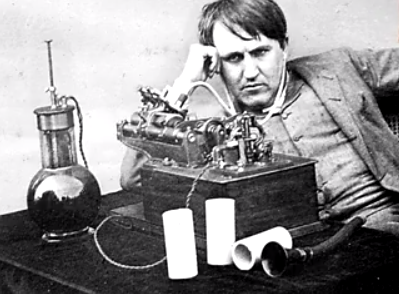---文章来源:coursera
让我们来看看历史上的一些名人是如何用不同的思考模式来帮助他们解决问题的。
let's take a look at some famous people from history who used their different thinking modes to help them with their problem solving.

上图这个家伙,名叫萨尔瓦多·达利 ( Salvador Dalí ),是20世纪著名的超现实主义画家,可谓是个标准的野兽和疯子,手上拿着的是宠物豹猫Babou。
Look at that guy right there, he was Salvador Dali, a very well known Surrealist painter of the 20th century. He was the very definition of a wild and crazy guy. You can see him here with his pet ocelot, Babou.
达利曾用过一种很有意思的方法来帮助他创作那些创意无限的超现实派画作。他会坐在椅子上,放空自己的大脑,并常常会漫无目的地思考一下之前的工作。他会手拿一把钥匙,在地面上方晃来晃去,当他睡着进入梦乡的时候,钥匙会从手里摔到地上发出哒的一声,恰到好处地把他叫醒。这样他就能把脑海中那些在发散模式下得到的的联想和点子及时地收集起来,然后他会带着这些在发散模式下得到的新想法,回到专注模式里去。
DalĂ used to have an interesting technique to help him come up with his fantastically creative Surrealist paintings. He'd relax in a chair and let his mind go free, often still vaguely thinking about what he had been previously focusing on. He'd have a key in his hand, dangling it just above the floor. And as he would slip into his dreams, falling asleep, the key would fall from his hand [SOUND] and the clatter would wake him up, just in time so he could gather up those diffuse mode connections and ideas in his mind. And off he'd go back into the focused mode bringing with him the new connections he'd made while in the diffuse mode.
那你们可能会想,没错,对艺术家来说这没问题。但这对更为科学或者具有数学性的思考又有什么帮助呢?
Now you might think, well, you know, that's okay for an artist, but what is it have to do with more scientific or mathematical kinds of thinking?

好,接下来登场的这个家伙叫托马斯·爱迪生 ( Thomas Edison ) ,史上最杰出的发明家之一。据传,爱迪生会坐在椅子上放松,手上抓几个滚珠轴承,他会放松自己的身体和意识,尽管他会经常以更为放松的方式回想之前的工作。
Well, if you look down here, this guy was Thomas Edison, one of the most brilliant inventors ever. According to legend, what Edison used to do was he'd sit and relax in his chair, holding ball bearings in his hand. He'd relax away letting his mind run free, although it would often noodle back in a much more relaxed way to what he'd been focusing on previously.
当爱迪生睡着的时候,那些滚珠轴承就会掉到地上,发出哒的一声,就和达利 (的钥匙) 一样,这样就会吵醒爱迪生,然后他就可以带着发散模式下得到的点子回到专注模式当中。所以这里要强调的是,当你学习一些新的东西,尤其是比较难的东西的时候,你的大脑需要有一种在两种学习模式之间来回转换的能力,这能帮助你更高效地学习。你可以把它和通过举重来提升力量做类比。你不可能直到某次举重比赛的前一天再花一整天时间来进行魔鬼训练。我是说,这样根本行不通。想要获得肌肉,你就必须每天做一点锻炼,让它们逐步增长。类似地,想要锻炼你的神经 你就需要每天做一点练习,逐步建立起支撑你思考的神经骨架,每天做一点,这就是关键所在。
When Edison would fall asleep, the ball bearings would drop [NOISE] and clatter to the ground just as with DalĂ. And it would wake Edison up and off he'd go with his ideas from the diffuse mode, ready to take them into the focused mode and build on them. So the bottom line is, when you're learning something new, especially something that's a little more difficult, your mind needs to be able to go back and forth between the two different learning modes. That's what helps you learn effectively. You might think of it as a bit analogous to building your strength by lifting weights. You would never plan to compete in a weight lifting competition by waiting until the very day before a meet and then spending that entire day working out like a fiend. I mean, it just doesn't happen that way. To gain muscular structure, you need to do a little work every day, gradually allowing your muscles to grow. Similarly, to build neuro-structure, you need to do a little work every day, gradually allowing yourself to grow a neuro-scaffold to hang your thinking on, a little bit every day and that's the trick.
(2)学习了大脑的两种不同的思考模式:专注和发散,它们都能帮助我们学习,只不过是用完全不同的方式;
(3)学习困难的东西需要相当的时间,你的大脑需要转变它的学习方式,以此来努力面对和消化新的事物。
In summary then, we learned that analogies provide powerful techniques for learning. We learned about how the brain's two different thinking modes, focused and diffuse, each helps us learn, but in very different ways. And finally, we learn that learning something difficult can take time. Your brain needs to alternate its ways of learning as it grapples with and assimilates the new material.